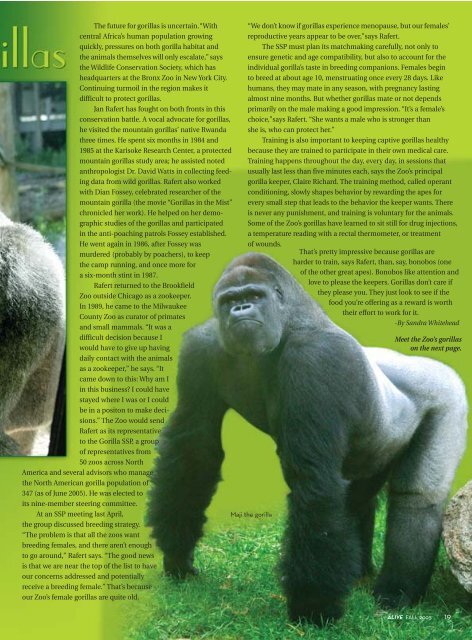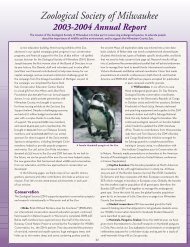AliveFall 2005 - Zoological Society of Milwaukee
AliveFall 2005 - Zoological Society of Milwaukee
AliveFall 2005 - Zoological Society of Milwaukee
You also want an ePaper? Increase the reach of your titles
YUMPU automatically turns print PDFs into web optimized ePapers that Google loves.
The future for gorillas is uncertain.“With<br />
central Africa’s human population growing<br />
quickly, pressures on both gorilla habitat and<br />
the animals themselves will only escalate,” says<br />
the Wildlife Conservation <strong>Society</strong>, which has<br />
headquarters at the Bronx Zoo in New York City.<br />
Continuing turmoil in the region makes it<br />
difficult to protect gorillas.<br />
Jan Rafert has fought on both fronts in this<br />
conservation battle. A vocal advocate for gorillas,<br />
he visited the mountain gorillas’ native Rwanda<br />
three times. He spent six months in 1984 and<br />
1985 at the Karisoke Research Center, a protected<br />
mountain gorillas study area; he assisted noted<br />
anthropologist Dr. David Watts in collecting feeding<br />
data from wild gorillas. Rafert also worked<br />
with Dian Fossey, celebrated researcher <strong>of</strong> the<br />
mountain gorilla (the movie “Gorillas in the Mist”<br />
chronicled her work). He helped on her demographic<br />
studies <strong>of</strong> the gorillas and participated<br />
in the anti-poaching patrols Fossey established.<br />
He went again in 1986, after Fossey was<br />
murdered (probably by poachers), to keep<br />
the camp running, and once more for<br />
a six-month stint in 1987.<br />
Rafert returned to the Brookfield<br />
Zoo outside Chicago as a zookeeper.<br />
In 1989, he came to the <strong>Milwaukee</strong><br />
County Zoo as curator <strong>of</strong> primates<br />
and small mammals. “It was a<br />
difficult decision because I<br />
would have to give up having<br />
daily contact with the animals<br />
as a zookeeper,” he says. “It<br />
came down to this: Why am I<br />
in this business? I could have<br />
stayed where I was or I could<br />
be in a positon to make decisions.”<br />
The Zoo would send<br />
Rafert as its representative<br />
to the Gorilla SSP, a group<br />
<strong>of</strong> representatives from<br />
50 zoos across North<br />
America and several advisors who manage<br />
the North American gorilla population <strong>of</strong><br />
347 (as <strong>of</strong> June <strong>2005</strong>). He was elected to<br />
its nine-member steering committee.<br />
At an SSP meeting last April,<br />
the group discussed breeding strategy.<br />
“The problem is that all the zoos want<br />
breeding females, and there aren’t enough<br />
to go around,” Rafert says. “The good news<br />
is that we are near the top <strong>of</strong> the list to have<br />
our concerns addressed and potentially<br />
receive a breeding female.” That’s because<br />
our Zoo’s female gorillas are quite old.<br />
“We don’t know if gorillas experience menopause, but our females’<br />
reproductive years appear to be over,”says Rafert.<br />
The SSP must plan its matchmaking carefully, not only to<br />
ensure genetic and age compatibility, but also to account for the<br />
individual gorilla’s taste in breeding companions. Females begin<br />
to breed at about age 10, menstruating once every 28 days. Like<br />
humans, they may mate in any season, with pregnancy lasting<br />
almost nine months. But whether gorillas mate or not depends<br />
primarily on the male making a good impression. “It’s a female’s<br />
choice,”says Rafert. “She wants a male who is stronger than<br />
she is, who can protect her.”<br />
Training is also important to keeping captive gorillas healthy<br />
because they are trained to participate in their own medical care.<br />
Training happens throughout the day, every day, in sessions that<br />
usually last less than five minutes each, says the Zoo’s principal<br />
gorilla keeper, Claire Richard. The training method, called operant<br />
conditioning, slowly shapes behavior by rewarding the apes for<br />
every small step that leads to the behavior the keeper wants. There<br />
is never any punishment, and training is voluntary for the animals.<br />
Some <strong>of</strong> the Zoo’s gorillas have learned to sit still for drug injections,<br />
a temperature reading with a rectal thermometer, or treatment<br />
<strong>of</strong> wounds.<br />
That’s pretty impressive because gorillas are<br />
harder to train, says Rafert, than, say, bonobos (one<br />
<strong>of</strong> the other great apes). Bonobos like attention and<br />
love to please the keepers. Gorillas don’t care if<br />
they please you. They just look to see if the<br />
food you’re <strong>of</strong>fering as a reward is worth<br />
their effort to work for it.<br />
-By Sandra Whitehead<br />
Maji the gorilla<br />
Meet the Zoo’s gorillas<br />
on the next page.<br />
ALIVE FALL <strong>2005</strong> 19













